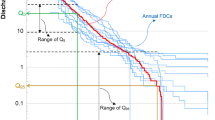Abstract
In the gauging station which tidal current effects are dominant, the reliable measuring methods are needed. In this study, the stage height difference is considered to derive the rating curve and the index velocity is considered to derive the mean velocity equation which discharge results from these equations are compared with the measured discharge collected in the Samrangjin station where tidal current effects are dominant. A robust minimum covariance determinant method, one of the nonlinear multi-regression methods, is applied to derive regression equations for the rating curve and mean velocity equation using 39 measurements collected at Samrangjin gauging station. The new rating curves allow superior in predicting discharge more precisely in tidily affected river as compared to existing equation. The discharge estimated using the mean velocity from the index velocity is in best agreement with the measured discharge data.
Similar content being viewed by others
References
Cheong, T. S. and Seo, I. W. (2003). “Parameter estimation of the transient storage model by routing method for river mixing processes.” Water Resources Research, Vol. 39, pp. HWC 1-1–1-11.
Chow. (1986). Open-Channel Hydraulics, McGraw-Hill, Singapore, pp. 70–74.
Chu, T., Kim, H., Kim, M., and Kim, C. (2000). “The development of the rating curves in the tidally affected rivers.” Proceedings of Korea Water Researches Association, KWRA, pp. 535–540.
Coulibaly, P., Anctil, F., and Bobe, B. (2000b). “Neural network-based long-term hydropower forecasting system.” J. Comp. Aided Civ. And Infrastruct. Engrg., Vol. 15, No. 5, pp. 355–364.
Coulibaly, P., Anctil, F.. and Bobe, B. (2000a). “Daily reservoir inflow forecasting using artificial neural networks with stopped training approach.” J. Hydro., Vol. 230, No. 4, pp. 244–257.
Godin, G. (1985). “Modification of river tides by the discharge.” Journal of Waterway, Port, Coastal, and Ocean Eng, ASCE, Vol. 3, No. 2, pp. 257–275.
Hubert, M. and Engelen, S. (2004). “Robust PCA and classification in biosciences.” Bioinformatics, Vol. 20, No. 11, pp.1728–1736.
Kim, C. Y., Kim, W., Lee, C. J., and Kim, D. G. (2007). “Analysis of looped stage-discharge relation characteristics using field measurement data.” KSCE Conference, pp. 1301–1304.
Kim, S. (2004). “Neural networks model for analysis of input information uncertainty in the small catchment.” Proc., World Water & Environmental Resources Congress 2004, ASCE/EWRI, Salt Lake City, UT.
Kim, S. and Cho, J. S. (2003). “Uncertainty analysis of flood stage forecasting using time-delayed patterns in the small catchment.” International Symposium on Disaster Mitigation and Basin-Wide Water Management Niigata 2003, IAHR/AIRH, Niigata, Japan, pp. 465–474.
Kim, S., Cho, J. S., and Park, J. K. (2003). “Hydrological analysis using the neural networks in the parallel reservoir groups, South Korea.” Proc., World Water & Environmental Resources Congress 2003, ASCE/EWRI, Philadelphia, PA.
Kim, S. and Lee, S. (2000). “Forecasting of flood stage using neural networks in the Nakdong river, South Korea.” Proc., Watershed Management & Operations Management 2000, ASCE/EWRI, Fort Collins, CO.
Lambie, J. C. (1978). “Measurement of flow-velocity-area methods.” Hydrometry: Principles and Practices, In: Hershcy, R. W. ed., Wiley, Chichester, Chapter 1.
Lee, J. and Hwang, M. (1994). “The research for the stage height-discharge equation in the lower region of Sumjin River.” Journal of Korea Water Researches Association, Vol. 27, No. 2, pp. 115–121.
Liong, S. Y., Lim, W. H., and Paudyal, G. N. (2000). “River stage forecasting in Bangladesh: Neural network approach.” J. of Comp., in Civ. Engr., Vol. 14, No. 1, pp. 1–8.
Morlock, S. E. (1994). Evaluation of acoustic Doppler current profiler measurements of river discharge, Water Resources Investigations Report 95-4218, U.S. Geological Survey.
Morlock, S. E., Nguyen, H. T., and Ross, J. H. (2002). Feasibility of acoustic Doppler velocity meters for the production of discharge records from U.S. Geological Survey Streamflow Gauging Stations, Water Resources Investigations Report 01-4157, U.S. Geological Survey.
Munson, B. R., Young, D. F., and Okiishi, T. H. (1990). Fundamentals of fluid mechanics, New York, John Wiley & Sons.
Oh, J., Kim, B., Kim, H., and Seoh, B. (2005). “An estimation technique of flood discharge.” Journal of Korean Society of Civil Engineers, Vol. 25, No. 4, pp. 207–213.
Rantz, S. E. and others. (1982). Measurement and computation of streamflow volume 1: Measurement of stage and discharge volume 2: Computation of discharge, U.S. Geological Survey, Water Supply Paper 2175.
Ruhl, C. A. and Simpson, M. R. (2005). Measurement and computation of streamflow computation of discharge, Scientific Investigation Report 2005-5004, U.S. Geological Survey.
Shin, H. S. and Park, M. J. (1999). “Spatial-temporal drought analysis of South Korea based on neural networks.” J. of Korean Water Resour. Assoc., Vol. 32, No. 1, pp. 15–29 (In Korean).
Simpson, M. R. (2001). Discharge measurements using a broad-band acoustic Doppler current profiler, Open File Report 01-1, U.S. Geological Survey.
Simpson, M. R. and Bland, R. (1999). “Techniques for accurate estimation of net discharge in a tidal channel.” IEEE Sixth Working Conference on Current Measurement, San Diego: CA, pp. 125–130.
Simpson, M. R. and Oltmann, R. N. (1993). Discharge-measurement system using an acoustic Doppler current profiler with applications to large rivers and estuaries, U.S. Geological Survey Water-Supply Paper 2395.
SonTek Corporation. (2000). SonTek ADVM-series instruments technical documentation, San Diego, CA.
Verboven, S. and Hubert, M. (2005). “LIBRA: a Matlab library for robust analysis.” Chemometrics and Intelligent Laboratory Systems, Vol. 75, No. 7, pp. 127–136.
Zealand, C. M., Burn, D. H., and Simonovic, S. P. (1999). “Short term streamflow forecasting using artificial neural networks.” J. Hydro., Vol. 214, No. 1, pp. 32–48.
Author information
Authors and Affiliations
Corresponding author
Rights and permissions
About this article
Cite this article
Lee, S., Cheong, T.S. Development of regression equations for the water discharge estimation in tidally affected rivers. KSCE J Civ Eng 13, 195–203 (2009). https://doi.org/10.1007/s12205-009-0195-4
Received:
Revised:
Accepted:
Published:
Issue Date:
DOI: https://doi.org/10.1007/s12205-009-0195-4




